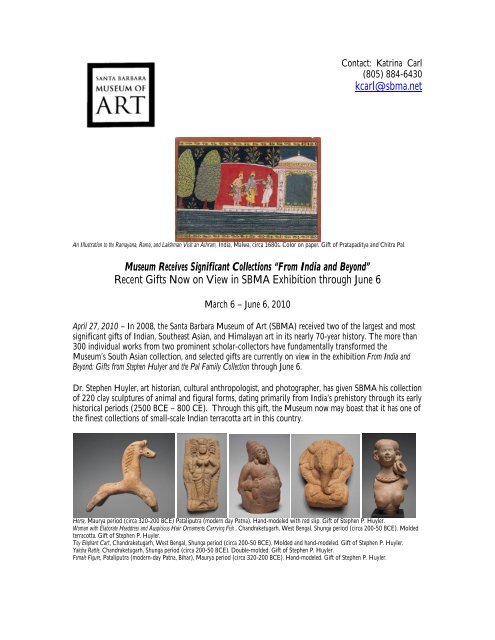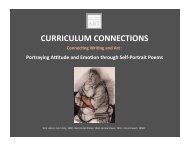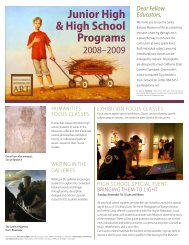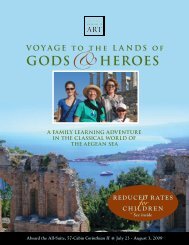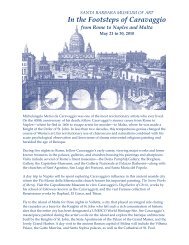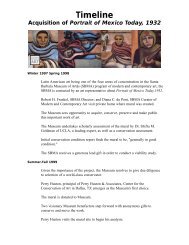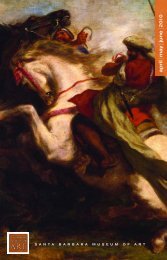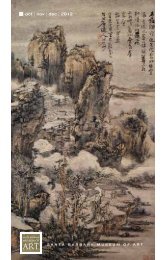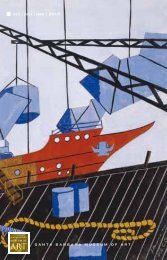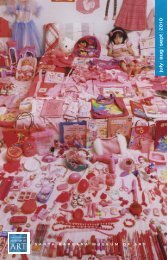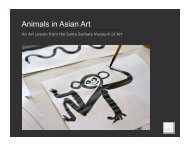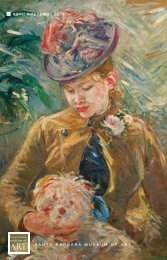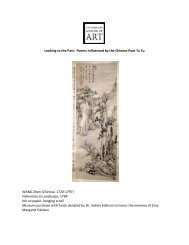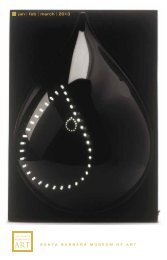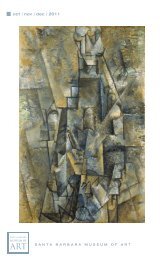From India and Beyond - Santa Barbara Museum of Art
From India and Beyond - Santa Barbara Museum of Art
From India and Beyond - Santa Barbara Museum of Art
You also want an ePaper? Increase the reach of your titles
YUMPU automatically turns print PDFs into web optimized ePapers that Google loves.
Contact: Katrina Carl<br />
(805) 884-6430<br />
kcarl@sbma.net<br />
An Illustration to the Ramayana, Rama, <strong>and</strong> Lakshman Visit an Ashram, <strong>India</strong>, Malwa, circa 1680s. Color on paper. Gift <strong>of</strong> Pratapaditya <strong>and</strong> Chitra Pal.<br />
<strong>Museum</strong> Receives Significant Collections “<strong>From</strong> <strong>India</strong> <strong>and</strong> <strong>Beyond</strong>”<br />
Recent Gifts Now on View in SBMA Exhibition through June 6<br />
March 6 – June 6, 2010<br />
April 27, 2010 – In 2008, the <strong>Santa</strong> <strong>Barbara</strong> <strong>Museum</strong> <strong>of</strong> <strong>Art</strong> (SBMA) received two <strong>of</strong> the largest <strong>and</strong> most<br />
significant gifts <strong>of</strong> <strong>India</strong>n, Southeast Asian, <strong>and</strong> Himalayan art in its nearly 70-year history. The more than<br />
300 individual works from two prominent scholar-collectors have fundamentally transformed the<br />
<strong>Museum</strong>’s South Asian collection, <strong>and</strong> selected gifts are currently on view in the exhibition <strong>From</strong> <strong>India</strong> <strong>and</strong><br />
<strong>Beyond</strong>: Gifts from Stephen Hulyer <strong>and</strong> the Pal Family Collection through June 6.<br />
Dr. Stephen Huyler, art historian, cultural anthropologist, <strong>and</strong> photographer, has given SBMA his collection<br />
<strong>of</strong> 220 clay sculptures <strong>of</strong> animal <strong>and</strong> figural forms, dating primarily from <strong>India</strong>’s prehistory through its early<br />
historical periods (2500 BCE – 800 CE). Through this gift, the <strong>Museum</strong> now may boast that it has one <strong>of</strong><br />
the finest collections <strong>of</strong> small-scale <strong>India</strong>n terracotta art in this country.<br />
Horse, Maurya period (circa 320-200 BCE) Pataliputra (modern day Patna). H<strong>and</strong>-modeled with red slip. Gift <strong>of</strong> Stephen P. Huyler.<br />
Woman with Elaborate Headdress <strong>and</strong> Auspicious Hair Ornaments Carrying Fish , Ch<strong>and</strong>raketugarh, West Bengal, Shunga period (circa 200-50 BCE). Molded<br />
terracotta. Gift <strong>of</strong> Stephen P. Huyler.<br />
Toy Elephant Cart, Ch<strong>and</strong>raketugarh, West Bengal, Shunga period (circa 200-50 BCE). Molded <strong>and</strong> h<strong>and</strong>-modeled. Gift <strong>of</strong> Stephen P. Huyler.<br />
Yaksha Rattle, Ch<strong>and</strong>raketugarh, Shunga period (circa 200-50 BCE). Double-molded. Gift <strong>of</strong> Stephen P. Huyler.<br />
Female Figure, Pataliputra (modern-day Patna, Bihar), Maurya period (circa 320-200 BCE). H<strong>and</strong>-modeled. Gift <strong>of</strong> Stephen P. Huyler.
Animals, birds, <strong>and</strong> male <strong>and</strong> female figures feature prominently among terracotta art from <strong>India</strong>’s<br />
prehistory to the present day. Many <strong>of</strong> these figurines were created as votive <strong>of</strong>ferings for the gods while<br />
many were images <strong>of</strong> deities used in worship. Others are toys, some <strong>of</strong> which were equipped with wheels<br />
<strong>and</strong> pellets inside as rattles, while others are simply ornaments. The abundance <strong>of</strong> female forms suggests the<br />
importance <strong>of</strong> mother-goddess worship. The well-endowed female body, sometimes decorated with floral<br />
<strong>and</strong> vegetal motifs, signify fertility <strong>and</strong> abundance, longings that stem from <strong>India</strong>’s agrarian culture. More<br />
specific deities include the Yaksha <strong>and</strong> Yakshi, the Hindu mythological custodians <strong>of</strong> natural treasures.<br />
Yaksha <strong>and</strong> Yakshi were among the earliest <strong>of</strong> deities represented in <strong>India</strong>, preceding images <strong>of</strong> Buddhist<br />
bodhisattvas <strong>and</strong> later Hindu deities. In their benevolent or demonic manifestations, they are powerful<br />
deities, capable <strong>of</strong> protecting human beings from disasters. They also bring about prosperity, happiness,<br />
<strong>and</strong> good health <strong>and</strong> are considered auspicious.<br />
Essentially ephemeral, many terracotta sculptures were made for daily use or seasonal festivals while others,<br />
such as those adorning monumental architecture, were intended to last longer. Because clay is abundant,<br />
inexpensive, <strong>and</strong> can be easily shaped <strong>and</strong> replaced, many <strong>of</strong> these sculptures are notable for their playfulness<br />
<strong>and</strong> imagination. Clay artisans in <strong>India</strong> continue the tradition to this day, improvising, experimenting, <strong>and</strong><br />
fashioning sculptures with great spontaneity <strong>and</strong> vitality.<br />
The Pal Family collection gift, dating from the 2nd century to the early 20th century, has greatly exp<strong>and</strong>ed<br />
the scope <strong>of</strong> SBMA’s collection <strong>of</strong> <strong>India</strong>n pictorial art, including manuscript illustrations, miniature<br />
paintings, drawings, popular paintings from Orissa <strong>and</strong> West Bengal, <strong>and</strong> works from the British colonial<br />
period. It also includes important Hindu <strong>and</strong> Buddhist stone <strong>and</strong> bronze sculptures from Kashmir, Nepal,<br />
<strong>and</strong> Tibet as well as paintings from Myanmar (Burma) <strong>and</strong> Sri Lanka.<br />
Saint Mirabai, Pemji <strong>of</strong> Chitod, <strong>India</strong>, Mewar, Rajasthan, dated 1838. Color <strong>and</strong> gold on paper. Gift <strong>of</strong> Pratapaditya <strong>and</strong> Chitra Pal<br />
Vishnu, Kashmir, 8th century. Green stone. Gift <strong>of</strong> Pratapaditya <strong>and</strong> Chitra Pal.<br />
Krishna Begs Forgiveness at Radha’s Feet, <strong>India</strong>, Kolkata (Calcutta), West Bengal, late 19 th century. Pencil, color, <strong>and</strong> silver on paper. Gift <strong>of</strong> Pratapaditya<br />
<strong>and</strong> Chitra Pal<br />
Bearded Goddess Durga with Lion, <strong>India</strong>, Bikaner, 18th century, color <strong>and</strong> gold on paper. Gift <strong>of</strong> Pratapaditya <strong>and</strong> Chitra Pal.<br />
The examples <strong>of</strong> pictorial art usually illustrate the most significant cultural <strong>and</strong> religious tales. Ramayana is<br />
one <strong>of</strong> the two great epics <strong>of</strong> <strong>India</strong> dealing with the story <strong>of</strong> Rama (an incarnation <strong>of</strong> the Hindu god<br />
Vishnu), his wife Sita, <strong>and</strong> brother Lakshmana. The lead image depicts the scene when Rama <strong>and</strong><br />
Laksmana visited the hermitage <strong>of</strong> a female ascetic during their stay in the forest.<br />
Goddess Durga is the consort <strong>of</strong> the Hindu god Shiva. Together, Shiva <strong>and</strong> Durga represent the male <strong>and</strong><br />
female principles <strong>of</strong> the cosmos. The above, far right image, is a representation <strong>of</strong> Durga with both<br />
principles combined symbolically to suggest that they are in fact inseparable, a non-duality. The feminine<br />
face <strong>of</strong> Durga is shown with a beard <strong>and</strong> holding some <strong>of</strong> Shiva’s attributes —an hourglass-like drum, a<br />
trident, <strong>and</strong> a beggar’s bowl. She is not, however, without attributes to identify her as the great goddess
Durga. In her h<strong>and</strong>s one finds swords <strong>and</strong> a garl<strong>and</strong> <strong>of</strong> white flowers as well as a voluminous scarlet pouch<br />
hanging from her left shoulder. Her animal vehicle, the lion, licks its paws, ready to give her a ride.<br />
<strong>From</strong> <strong>India</strong> <strong>and</strong> <strong>Beyond</strong> celebrates the beauty <strong>and</strong> diversity <strong>of</strong> South Asian art through the distinctive visions <strong>of</strong><br />
two scholars whose life-long collecting <strong>and</strong> generosity have so enriched this <strong>Museum</strong>. In recent<br />
conversations with the collectors, both Dr. Huyler <strong>and</strong> Dr. Pal expressed a growing sense <strong>of</strong> detachment<br />
from worldly possessions, in the spirit <strong>of</strong> Hindu <strong>and</strong> Buddhist teachings that led to the gifting <strong>of</strong> their<br />
collections.<br />
More About the Donors:<br />
Dr. Stephen Huyler grew up in Ojai <strong>and</strong> credits his lifelong fascination with the arts <strong>and</strong> crafts <strong>of</strong> <strong>India</strong> to<br />
the mentorship <strong>of</strong> his neighbors, F. Bailey V<strong>and</strong>erhoef, Jr., late Trustee <strong>and</strong> major benefactor <strong>of</strong> the<br />
<strong>Museum</strong>, <strong>and</strong> Beatrice Wood, renowned ceramic artist. In 1986 at the Brooklyn <strong>Museum</strong> <strong>of</strong> <strong>Art</strong>, Huyler<br />
assisted in curating the first major exhibition devoted to the subject <strong>of</strong> <strong>India</strong>n terracotta art, <strong>From</strong> <strong>India</strong> Earth:<br />
400 Years <strong>of</strong> Terracotta <strong>Art</strong>. Ten years later, he published Gifts <strong>of</strong> Earth: Terracottas <strong>and</strong> Clay Sculptures <strong>of</strong> <strong>India</strong><br />
(1996), an intensive study <strong>of</strong> the <strong>India</strong>n potters' <strong>and</strong> clay sculptors’ art today.<br />
Dr. Pratapaditya Pal remains one <strong>of</strong> the most influential forces in advancing the interest <strong>and</strong> underst<strong>and</strong>ing<br />
<strong>of</strong> South Asian <strong>and</strong> Himalayan art. Over a four decade long curatorial career, Pratapaditya Pal has been<br />
associated with the <strong>Museum</strong> <strong>of</strong> Fine <strong>Art</strong>s, Boston, Los Angeles County <strong>Museum</strong> <strong>of</strong> <strong>Art</strong>, Norton Simon<br />
<strong>Museum</strong>, Pasadena <strong>and</strong> the <strong>Art</strong> Institute <strong>of</strong> Chicago. Currently he is General Editor <strong>of</strong> Marg Publications,<br />
Mumbai. Dr. Pal characterizes his private collecting as driven by idiosyncratic preferences <strong>and</strong>, to avoid<br />
conflicts <strong>of</strong> interest, outside the main focuses <strong>of</strong> the museum collections he oversaw. Consequently, the Pal<br />
collection is diverse, <strong>of</strong>fering fresh insight into the rich history <strong>of</strong> art <strong>and</strong> culture in South Asia.<br />
Related Programming:<br />
Free Lecture<br />
Experiencing <strong>India</strong>n <strong>Art</strong> <strong>and</strong> Culture: Dialogues with Dr. Stephen Huyler <strong>and</strong> Dr. Pratapaditya Pal<br />
Sunday, May 2, 10 am - 3:30 pm<br />
In celebration <strong>of</strong> the significant gifts <strong>of</strong> <strong>India</strong>n <strong>and</strong> South Asian art, this program features these two<br />
distinguished scholar-collectors who will share their passion <strong>and</strong> knowledge <strong>of</strong> the rich art <strong>and</strong> culture <strong>of</strong><br />
<strong>India</strong>. Additional participants include Gerald Larson, pr<strong>of</strong>essor emeritus <strong>of</strong> Religious Studies at UC <strong>Santa</strong><br />
<strong>Barbara</strong> <strong>and</strong> Susan Tai, Elizabeth Atkins Curator <strong>of</strong> Asian <strong>Art</strong> at SBMA. Closing remarks by Consul<br />
General Susmita G. Thomas <strong>of</strong> <strong>India</strong>.<br />
Mary Craig Auditorium. Seating is limited. First come, first seated.<br />
Program:<br />
10 am: Experiencing <strong>India</strong> <strong>and</strong> the <strong>Art</strong> <strong>of</strong> Terracotta<br />
Dr. Huyler <strong>and</strong> Dr. Pal<br />
1:30 pm: <strong>India</strong>n <strong>Art</strong> <strong>and</strong> Culture<br />
Dr. Pal <strong>and</strong> Pr<strong>of</strong>essor Gerald Larson<br />
The <strong>Santa</strong> <strong>Barbara</strong> <strong>Museum</strong> <strong>of</strong> <strong>Art</strong> is a privately funded, not-for-pr<strong>of</strong>it institution that presents<br />
internationally recognized collections <strong>and</strong> exhibitions <strong>and</strong> a broad array <strong>of</strong> cultural <strong>and</strong> educational activities<br />
as well as travel opportunities around the world.<br />
<strong>Santa</strong> <strong>Barbara</strong> <strong>Museum</strong> <strong>of</strong> <strong>Art</strong>, 1130 State Street, <strong>Santa</strong> <strong>Barbara</strong>, CA.<br />
Open Tuesday - Sunday 11 am to 5 pm. Closed Monday.<br />
805.963.4364 www.sbma.net


